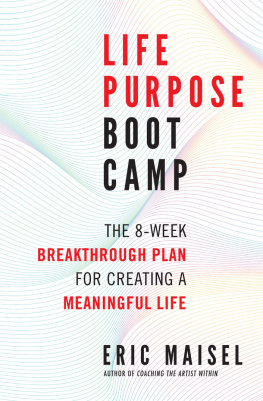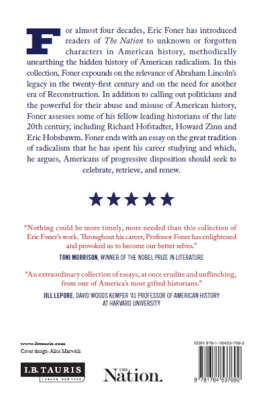Contents
Guide
Page List
A CRAFTSMAN'S LEGACY
Why Working with Our Hands Gives Us Meaning
ERIC GORGES
with Jon Sternfeld

ALGONQUIN BOOKS OF CHAPEL HILL
Published by
Algonquin Books of Chapel Hill
Post Office Box 2225
Chapel Hill, North Carolina 27515-2225
a division of
Workman Publishing
225 Varick Street
New York, New York 10014
2019 by Eric Gorges. All rights reserved.
Axe Handles copyright 1983 by Gary Snyder. Reprinted by permission of Counterpoint.
LIBRARY OF CONGRESS CATALOGING-IN-PUBLICATION DATA
LC record available at https://lccn.loc.gov/2018042246
eISBN: 978-1-61620-944-5
CONTENTS

INTRODUCTION: FROM OUR HANDS
We find only one tool, neither created nor invented, but perfect: the hand of man. julio ramn ribeyro
I build custom motorcycles for a living, so as a craftsman, I work with a variety of materials, tools, and machines. But my primary tools will always be my hands. And, to be honest, mine have been through the grinder.
Any dreams of becoming a famous hand model have burned to the ground. My thumb is currently an alarming shade of blacksmashed from having two pounds of metal dead dropped on it. My hands bleed all the time, their skin is rough and cracked like a dirt road, and theres a gnarly scar across my right index knuckle. I have scars on my hands that go back years, injuries whose sources have been lost to my memory.
I think of them all as badges of honor. My hands are beat up from use. Hands tell a story, so it seems fitting then that when we greet someone, we shake hands. Its personal and intimate; it allows us to identify ourselves to each other and exchange information. For craftsmen, especially, our hands are often the extension of our desires and our vision. They are how we create, repair, and make an impact on the world.
Its why the idea of something being handmade is special. As mass production makes everything transitional and disposable, the personal object becomes even more valuable. I think about my grandparents going to buy furniture seventy years ago. Back then, it would have been a big decision, an event. They would have likely bought one piece of furniture at a timea table, a dresser, a sofaand that piece would be built to last, maybe for fifty years. They assumed their grandchildren would sit on that sofa one day. Nowadays, because of the convenience, were often buying things from a picture on the Internet. Our connection to the object is virtual, really an illusion. I believe we need to be able to touch something to truly know it. Ordinarily, the first thing I like to do before I buy furniture is the shake test; its an automatic thing, literally shaking the object. I get a look at the piece, a feel of the joinery, a sense of how it is all assembled. I want to know if itll last or if Im going to be back in the store next year.
Some months back I found myself on a Saturday afternoon staring at a few boxes. My girlfriend and I had recently broken up, and I had moved out and needed furniture. I work with my hands for a living, and I produce and host a show about the value of working with your hands, where I meet other people who work with their hands, but time and money were tight. So I did what most people do: I logged on to my computer and picked out a new couch online. Though Id eventually want furniture that would last, I needed something right away that would fit my current life situation. I had a short timeline and nowhere to sit.
A few days later, three different boxes showed up at my front door. I was looking at them with my daughter, trying to figure out what was in there. Was this my sofa? Split into three boxes? In one box was the couchs bottom. We unzipped it to find all the cushions packed inside, and then the other pieces, which were to be bolted together. That couch served a purpose, but it was never going to last long enough to be passed down to my daughter.
In the twenty-first century, weve become passive figures in the larger churning machine, further removed from how things are made, how they work, the people who made them, and how the dots all connect. As weve become distant from the rest of the world we have become more and more distant from each other. In some ways, weve become distant from ourselves. Thats why Im on a mission to celebrate craftsmanship.
This book features craftsmen, their work, and their way of life. Craftsmen were once the backbone of our country, but they have been pushed to the margins. Just like the things they make, however, they are resilient. On A Craftsmans Legacy, craftsmen invite me into their homes and shops, and I try what they do myself, right there in front of the camera.
Its been wonderful to see the recent resurgence of handmade items, and Im optimistic that will continue to expand the appreciation of and interest in craftsmanship. But we can all learn and be inspired through the spirit of craftsmen and their work, whether or not we make things ourselves. The lessons discussed here are universal. Maybe an understanding of the craftsmans ethic can help someone feel more grounded in their own life or bring the wisdom of the natural and mechanical worlds back into our homes, offices, and day-to-day existences.
In my estimation, craftsmen are heroic to me, and Im trying to do the little bit I can to shine the light back on them.

eric gorges
Detroit, Michigan

1: THE BATTLE FOR PERFECTION
We are what we repeatedly do. Excellence, then, is not an act, but a habit. aristotle
The first ten thousand pots are difficult. Then it gets a little bit easier. warren mackenzie , potter
Every time you get in the saddle, you are up against the impossible. No matter your years of experience or level of expertise, this is an immutable truth. Theres probably nothing more necessary in craftsmanship than accepting this fact. In the introduction to every episode of A Craftsmans Legacy I say that the craftsman battles for perfection. I use that word consciously because it is a battle; its a messy and valiant struggle that each one of us is bound to lose.
In accepting imperfection I am in good company, joining a long tradition that is practiced in cultures around the world. A Japanese aesthetic called wabi-sabi embraces the imperfect, and in Zen Buddhist tea ceremonies, the pots and cups have intentional irregularities in them. Orthodox Jews insist on putting a flaw in every house they construct as a reminder of their lost holy temple. The Navajo traditionally insert mistakes in their rugs because thats where the soul moves in and out of the rug. Islamic culture does the same thing with Persian rugs, as a testament to the fact that only God can make perfection.
Human beings simply cannot create perfection with our hands. We can make things eye-perfect, but measurements will never lie. An object made by hand will have that human stamp on it. Thats what gives a piece its soul. Rather than turn away from this reality, various cultures have decided to lean in to this fact.















